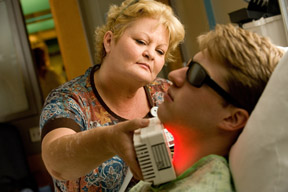Technology developed by NASA for growing plants on the space shuttle proved effective in reducing and healing painful mouth sores and inflammation caused by traditional treatments for cancer patients in a clinical trial at the University of Alabama at Birmingham.
|
|
|
Download image. |
This common, extremely painful side-effect — oral mucositis — affects nearly all patients undergoing high-dose chemotherapy. It causes pain, loss of taste perception, ulcers and makes it difficult to eat and drink. Nearly half develop such severe oral mucositis that their cancer treatment must be modified, potentially compromising their prognosis or prolonging hospitalization.
Cancer patients receiving bone-marrow and stem-cell transplants who were given this light treatment during a two-year clinical trial, performed in part at the University of Alabama at Birmingham Hospital’s Bone Marrow Transplant and Cellular Therapy Unit, reported their pain was reduced by almost half.
Use of Quantum Devices’ WARP 10/WARP 75 technology to deliver the light treatment, called High Emissivity Aluminiferous Luminescent Substrate, or HEALS, is undergoing pre-market approval by the U.S. Food and Drug Administration.
“Any chemotherapy that is strong enough to kill all of the bone marrow can affect other organs, and one of the principal areas of toxicity patients experience is mucositis,” said Donna Salzman, M.D., principal investigator at UAB and director of clinical services and education in the Bone Marrow Transplant and Cellular Therapy Unit. “Anything that can be done to help prevent or heal mucositis will make the transplant easier for the patient, which is very important to recovery.”
Patients who participated in the study were randomly placed in one of four groups: low- and high-risk patients receiving the HEALS light treatment; and other low- and high-risk patients receiving light through a similar device without therapeutic effects. Low-risk patients were those whose chemotherapy and radiation treatment caused mild or no mucositis. High-risk patients were those whose therapy treatment caused severe mucositis.
In the trial, a nurse administered the light therapy by holding the device – about the size of an adult human hand – on the outside of each of the patient’s cheeks and the front of their neck for 88 seconds in each spot, daily, for 14 days at the start of the patient’s bone-marrow or stem-cell transplant. For the 14 days they were treated, nurses looked at the patients’ mouths for signs to see if they developed mucositis and for those who did, nurses assessed its severity and patients completed a simple form to indicate their level of pain.
Salzman and her colleagues found a 96 percent chance that the improvement in pain of those in the high-risk patient group was the result of the HEALS treatment.
“This technology was effective as a healing agent,” Salzman said. “It was well-tolerated with no side-effects, such as diarrhea, as there could be using antibiotics. And, the patients we expected to have the most trouble with mucositis, those at high risk, reported as much as a 44 percent reduction in their pain scores, as well as statistically significant decrease in their mucositis.”
Decreasing the incidence and severity of mucositis, Salzman said, means decreasing pain and the need for narcotics and increasing the amount of nutrition patients are able to take without IV therapy.
“Essentially if you can get them off the narcotics faster and their mouths can heal faster, it is possible they could get out of the hospital sooner,” she said.
UAB and NASA have a long history of research collaboration. Some more recent NASA-sponsored projects at UAB include aerospace crew, robotics, avionics and equipment work performed by UAB’s Center for Biophysical Sciences and Engineering (CBSE) for spacewalk activity equipment, flight-crew health and conditioning systems, environmental control and life support equipment. UAB researchers also designed cryogenic freezer units called GLACIER, along with a smaller refrigerator called MERLIN, for continued use on the International Space Station and advanced NASA vehicles.
For patient information, please visit www.uabmedicine.org.

